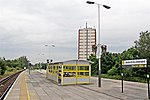Rimrose Valley

Rimrose Valley is a 3.5 km (2.2 mi) country park and valley which forms a border between Crosby and Litherland in the borough of Sefton, Merseyside, England, with the Leeds and Liverpool Canal on its eastern edge.Because the brook that runs through the park regularly floods, it remained clear of the housing developments that grew up on either side. However, the central area was used as a tip until 1978 and restoration began in 1993. Rimrose is a Hybrid word from Old English hrim (modern "rim"), 'border' and Celtic ros meaning "moor" or "heath".Following concern over young people riding scrambler bikes in the park, resulting in at least one serious accident, the police launched a crackdown in 2015. This led to the formation of Rimrose Valley Friends; a charity which works to promote, protect and enhance the park. The charity delivers activities and events which use the parkland to promote physical and mental health, community cohesion and projects which protect the natural environment.
Excerpt from the Wikipedia article Rimrose Valley (License: CC BY-SA 3.0, Authors, Images).Rimrose Valley
Beach Road,
Geographical coordinates (GPS) Address Nearby Places Show on map
Geographical coordinates (GPS)
| Latitude | Longitude |
|---|---|
| N 53.473 ° | E -3.01 ° |
Address
Beach Road
Beach Road
L21 2PN , Seaforth
England, United Kingdom
Open on Google Maps








